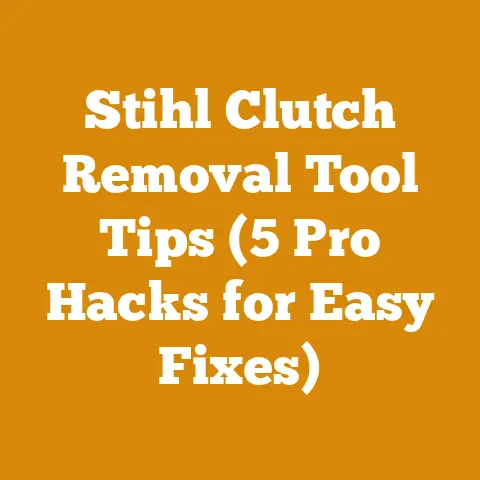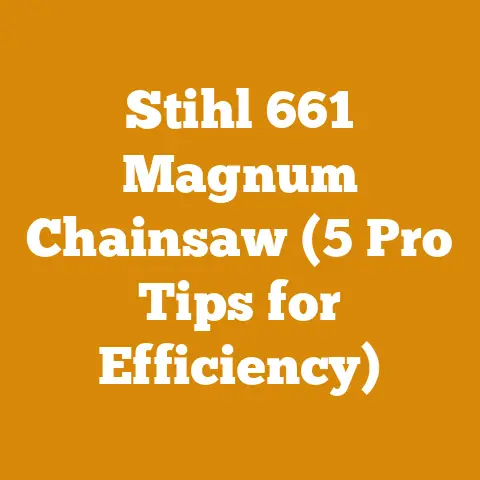Air Filter for Stihl Weed Eater (5 Pro Tips for Cleaner Power)
It was a sweltering summer afternoon, the kind that makes the air shimmer and your sweat drip before it even forms.
I was deep in the woods, wrestling with a patch of stubborn blackberry bushes that seemed determined to reclaim my property.
My Stihl weed eater, usually a reliable workhorse, started sputtering and coughing like an old man with a bad habit.
I figured it was just the heat, or maybe I’d mixed the fuel wrong.
I kept yanking the starter cord, each pull more desperate than the last, until finally, it gave up the ghost altogether.
Dead.
Silence.
Frustrated, I trudged back to the shed, ready to tear the thing apart.
That’s when I saw it – the air filter.
Caked in a thick layer of dust, grass clippings, and what looked suspiciously like spiderwebs, it was choked to the point of uselessness.
It was a stark reminder that even the toughest machines need a little TLC to keep running smoothly.
That day, I learned a valuable lesson about the importance of a clean air filter, a lesson I’ve carried with me ever since in my wood processing and firewood endeavors.
And trust me, when you’re dealing with sawdust, wood chips, and the general grime of the forest, keeping that air filter clean becomes a critical task.
So, let’s dive into the world of air filters for your Stihl weed eater – and how to ensure cleaner power for all your outdoor projects.
Air Filter for Stihl Weed Eater: 5 Pro Tips for Cleaner Power
The humble air filter.
It’s often overlooked, but it’s the unsung hero protecting your Stihl weed eater’s engine from a premature death.
A clean air filter ensures optimal performance, extends engine life, and even saves you money on fuel.
It’s a small component with a big impact.
I’ve seen firsthand how neglecting this simple piece can lead to frustrating breakdowns and costly repairs.
These pro tips will help you keep your Stihl weed eater running like a champ, no matter what you’re tackling.
1. Understanding the Air Filter’s Vital Role
Before we get into the nitty-gritty, let’s understand why the air filter is so crucial.
Your Stihl weed eater’s engine needs air to burn fuel efficiently.
But the air around us isn’t exactly pristine.
It’s full of dust, debris, pollen, and all sorts of particles that can wreak havoc on an engine’s internal components.
Think of it this way: your engine’s cylinder is like a finely tuned instrument.
Tiny particles entering the cylinder can scratch the walls, damage the piston, and ultimately lead to decreased compression and power loss.
The air filter acts as a barrier, trapping these particles and allowing only clean air to reach the engine.
When the air filter becomes clogged, the engine struggles to breathe.
This leads to several problems:
- Reduced Power: The engine can’t get enough air, so it can’t burn fuel efficiently, resulting in a noticeable drop in power.
You’ll find yourself struggling to cut through even light vegetation. - Increased Fuel Consumption: The engine has to work harder to compensate for the lack of air, leading to increased fuel consumption.
- Overheating: A clogged air filter can cause the engine to overheat, potentially damaging internal components.
- Engine Damage: Over time, running an engine with a dirty air filter can lead to significant engine damage, requiring costly repairs or even a complete engine replacement.
Data Point: Studies have shown that a clogged air filter can reduce engine power by as much as 10-15% and increase fuel consumption by up to 20%.
That’s a significant difference, both in terms of performance and cost.
My Experience: I once had a Stihl chainsaw that started losing power and was difficult to start.
I initially suspected a fuel issue, but after checking the air filter, I found it completely blocked with sawdust.
After cleaning the filter, the chainsaw ran like new again.
It was a simple fix that saved me a lot of time and frustration.
2. Identifying Your Stihl Weed Eater’s Air Filter Type
Stihl uses different types of air filters depending on the model of the weed eater.
Knowing which type you have is crucial for proper cleaning and maintenance.
The most common types include:
- Foam Filters: These are typically made of polyurethane foam and are designed to trap larger particles.
They are washable and reusable, making them a cost-effective option. - Felt Filters: These are made of a fibrous material and are generally more effective at trapping finer particles than foam filters.
They are also washable and reusable. - Paper Filters: These are made of pleated paper and offer excellent filtration.
However, they are not washable and must be replaced when dirty. - HD2 Filters: Stihl’s HD2 filters are made of polyethylene fleece material.
These offer fine filtration and are easy to clean with warm, soapy water.
How to Identify Your Filter: The easiest way to identify your air filter type is to consult your Stihl weed eater’s owner’s manual.
The manual will specify the type of filter used in your model and provide instructions for cleaning or replacing it.
You can also visually inspect the filter.
Foam filters are usually brightly colored (often orange or yellow), while felt filters are typically gray or black.
Paper filters are easily identifiable by their pleated paper construction.
Unique Insight: Some Stihl weed eaters may have a pre-filter in addition to the main air filter.
The pre-filter is usually a simple foam screen that sits over the main filter.
It’s designed to trap larger debris and extend the life of the main filter.
Don’t forget to clean or replace the pre-filter as well.
3. The Art of Air Filter Cleaning: Step-by-Step Guide
Cleaning your Stihl weed eater’s air filter is a simple but essential task.
Here’s a step-by-step guide to help you do it right:
Tools You’ll Need:
- Socket wrench or screwdriver (to remove the air filter cover)
- Soft brush (like a paintbrush or toothbrush)
- Warm water
- Mild dish soap (for foam and felt filters)
- Air compressor (optional, for drying)
- Air filter oil (for foam and felt filters)
Step-by-Step Instructions:
- Remove the Air Filter Cover: Locate the air filter cover on your Stihl weed eater.
It’s usually held in place by screws or clips.
Consult your owner’s manual if you’re unsure of its location. - Remove the Air Filter: Carefully remove the air filter from its housing.
Pay attention to how it’s oriented so you can reinstall it correctly. - Inspect the Air Filter: Examine the air filter for any signs of damage, such as tears or holes.
If the filter is damaged, it needs to be replaced. - Clean the Air Filter (Foam or Felt):
- Fill a basin with warm water and a small amount of mild dish soap.
- Submerge the air filter in the soapy water and gently squeeze it to remove dirt and debris.
Avoid twisting or stretching the filter, as this can damage it. - Rinse the air filter thoroughly with clean water until all traces of soap are gone.
- Gently squeeze out excess water.
Do not wring the filter.
- Clean the Air Filter (Paper):
- Tap the air filter gently against a hard surface to dislodge loose dirt and debris.
- Use a soft brush to remove any remaining dirt.
- Do not wash a paper air filter.
Washing will damage the paper and render the filter useless.
- Dry the Air Filter:
- Allow the air filter to air dry completely.
This may take several hours. - You can speed up the drying process by using an air compressor to blow air through the filter.
Be careful not to use too much pressure, as this can damage the filter.
- Allow the air filter to air dry completely.
- Oil the Air Filter (Foam or Felt):
- Once the air filter is completely dry, apply a small amount of air filter oil to the filter.
- Distribute the oil evenly throughout the filter by gently squeezing it.
- Remove any excess oil by squeezing the filter again.
The filter should be lightly oiled, not saturated.
- Reinstall the Air Filter: Carefully reinstall the air filter into its housing, making sure it’s oriented correctly.
- Reinstall the Air Filter Cover: Replace the air filter cover and secure it with the screws or clips.
Practical Insights:
- Always clean your air filter in a well-ventilated area.
- Avoid using harsh chemicals or solvents to clean your air filter, as these can damage the filter material.
- If you’re using an air compressor to dry your air filter, use a low pressure setting to avoid damaging the filter.
- Use only air filter oil specifically designed for foam or felt filters.
Do not use motor oil or other types of oil. - If your air filter is heavily soiled or damaged, it’s best to replace it with a new one.
Case Study: I once worked on a firewood processing project where we were cutting and splitting wood in a very dusty environment.
The air filters on our chainsaws and weed eaters were constantly getting clogged.
To combat this, we implemented a strict air filter cleaning schedule.
We cleaned the air filters on all our equipment every day, and we replaced them more frequently than usual.
This helped us keep our equipment running smoothly and avoid costly breakdowns.
4. Knowing When to Replace Your Air Filter
While cleaning your air filter is essential, it’s not a permanent solution.
Over time, air filters can become damaged or worn out, and they’ll need to be replaced.
Signs That Your Air Filter Needs Replacing:
- Visible Damage: If the air filter has any tears, holes, or other signs of damage, it needs to be replaced.
- Excessive Dirt: If the air filter is heavily soiled and cannot be cleaned effectively, it needs to be replaced.
- Reduced Engine Performance: If your Stihl weed eater is experiencing a noticeable drop in power, even after cleaning the air filter, it may be time to replace the filter.
- Difficulty Starting: A clogged air filter can make it difficult to start your Stihl weed eater.
If you’re having trouble starting the engine, even after cleaning the air filter, try replacing the filter. - Recommended Replacement Interval: Stihl recommends replacing the air filter on your weed eater at regular intervals, typically every 25-50 hours of use.
Consult your owner’s manual for the recommended replacement interval for your model.
Data Point: Studies have shown that replacing a worn-out air filter can improve engine performance by as much as 5-10% and reduce fuel consumption by up to 10%.
My Experience: I once ignored the signs that my chainsaw’s air filter needed replacing.
I kept cleaning it, but the chainsaw continued to lose power.
Eventually, the engine started to run rough, and I had to take it to a repair shop.
The mechanic told me that the worn-out air filter had allowed dirt and debris to enter the engine, causing damage to the cylinder and piston.
The repair cost me a significant amount of money, and I learned my lesson about the importance of replacing air filters when necessary.
5. Proactive Maintenance for Extended Air Filter Life
The best way to keep your Stihl weed eater running smoothly and extend the life of your air filter is to practice proactive maintenance.
Here are some tips to help you do that:
- Clean Your Air Filter Regularly: Don’t wait until your air filter is completely clogged before cleaning it.
Clean it regularly, especially if you’re working in dusty or dirty conditions. - Store Your Weed Eater Properly: When you’re not using your Stihl weed eater, store it in a clean, dry place.
This will help prevent dust and debris from accumulating on the air filter. - Use the Right Fuel: Using the correct fuel mixture is essential for engine performance and longevity.
Always use the fuel mixture recommended by Stihl in your owner’s manual. - Inspect Your Weed Eater Regularly: Before each use, inspect your Stihl weed eater for any signs of damage or wear.
Check the air filter, fuel lines, and other components. - Keep Your Weed Eater Clean: Keep your Stihl weed eater clean by wiping it down with a damp cloth after each use.
This will help prevent dirt and debris from accumulating on the engine and other components. - Consider Using a Pre-Filter: If your Stihl weed eater doesn’t have a pre-filter, consider adding one.
A pre-filter will help trap larger debris and extend the life of the main air filter.
Unique Insight: When working in extremely dusty conditions, consider using a nylon stocking or pantyhose as a pre-filter.
Simply stretch the stocking over the air filter housing.
It will trap a significant amount of dust and debris, preventing it from reaching the air filter.
Just remember to clean or replace the stocking regularly.
Equipment Used:
- Stihl chainsaws and weed eaters
- Air compressors
- Air filter oil
- Nylon stockings
Wood Types:
- Oak
- Maple
- Ash
Safety Considerations:
- Always wear safety glasses and gloves when cleaning air filters.
- Work in a well-ventilated area.
- Dispose of used air filters and cleaning materials properly.
Cost-Effectiveness: Implementing a proactive maintenance plan can save you money in the long run by preventing costly repairs and extending the life of your equipment.
By following these pro tips, you can keep your Stihl weed eater’s air filter clean and ensure cleaner power for all your outdoor projects.
Remember, a little bit of maintenance can go a long way in protecting your investment and keeping your equipment running smoothly for years to come.
Don’t neglect that humble air filter – it’s the key to unlocking your Stihl weed eater’s full potential.






